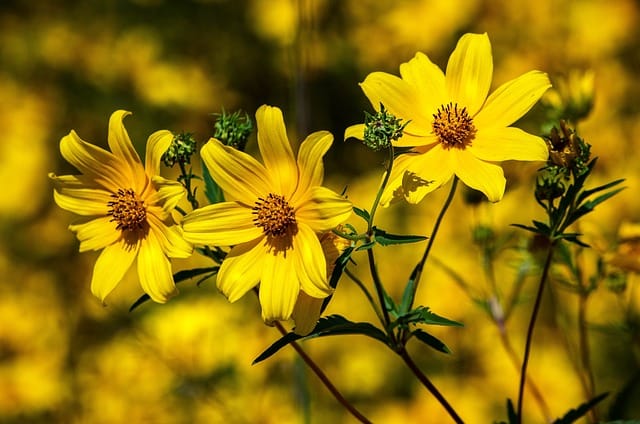How to grow Coreopses
The Coreopsis flower, also known as tickseed, is a beautiful perennial plant that belongs to the Asteraceae family

In this article:
- Introduction to Coreopsis Flower
- Choosing the Right Coreopsis Varieties
- Climate and Sunlight Requirements
- Soil Preparation and Planting
- Watering and Fertilizing
- Proper Care and Maintenance
- Dealing with Common Pests and Diseases
- Pruning and Deadheading Techniques
- Propagation Methods
- Overwintering Coreopsis
- Showcasing Coreopsis in the Garden
- Creative Uses and Arrangements for Cut Coreopsis Flowers
- Frequently Asked Questions about Coreopsis
Introduction to Coreopsis Flower
The Coreopsis flower, also known as tickseed, is a beautiful perennial plant that belongs to the Asteraceae family. With its vibrant colors and daisy-like blooms, Coreopsis is a popular choice for gardeners looking to add a splash of color to their landscape.
Choosing the Right Coreopsis Varieties
There are numerous Coreopsis varieties to choose from, each with its own unique characteristics. Some popular varieties include Coreopsis grandiflora, Coreopsis tinctoria, and Coreopsis lanceolata. Consider the plant's height, flower color, and bloom time when selecting the right variety for your garden.
Climate and Sunlight Requirements
Coreopsis thrives in full sun and prefers well-drained soil. It is best suited for USDA hardiness zones 4 to 9. Ensure your garden provides enough sunlight exposure for the Coreopsis plant to flourish.
Soil Preparation and Planting
Prepare the soil by removing any weeds, rocks, or debris. Coreopsis prefers slightly acidic to neutral pH soil. Incorporate compost or organic matter to improve soil fertility and drainage. Plant Coreopsis seedlings or young plants following the recommended spacing guidelines for the specific variety.
Watering and Fertilizing
Coreopsis is a relatively drought-tolerant flower but benefits from regular watering during dry spells. Provide deep watering once or twice a week, allowing the soil to dry between waterings. Apply a balanced fertilizer during the growing season to promote healthy growth and abundant blooms.
Proper Care and Maintenance
Regularly inspect your Coreopsis plants for signs of pests, diseases, or nutrient deficiencies. Remove weeds that compete for nutrients and water. Deadhead spent flowers to encourage continuous blooming. Mulch around the plants to prevent weed growth, retain soil moisture, and regulate temperature.
Dealing with Common Pests and Diseases
Common pests that may attack Coreopsis include aphids, slugs, and snails. Monitor your plants regularly and take appropriate measures such as handpicking or using organic insecticides to control infestations. Diseases such as powdery mildew and root rot can be prevented by providing good air circulation and proper drainage.
Pruning and Deadheading Techniques
Pruning Coreopsis is simple and promotes healthier growth. Cut back the plants to about half their height in late spring or early summer to encourage bushier growth. Deadheading spent flowers regularly throughout the blooming season will stimulate more blooms and keep the plant looking tidy.
Propagation Methods
Coreopsis can be propagated through seeds, division, or stem cuttings. Collect seeds from mature flowerheads and sow them in moist soil. Divide established clumps every few years, ensuring each division has sufficient roots. Stem cuttings can be taken from healthy plants and rooted in a suitable medium.
Overwintering Coreopsis
Most coreopsis varieties are hardy, but in colder regions, additional protection during winter is beneficial. Apply a layer of mulch around the plant base to insulate the roots. Remove dead foliage in the fall and cut back the stems after the first frost to prevent diseases and promote regrowth in spring.
Showcasing Coreopsis in the Garden
Coreopsis looks best when planted in drifts or groups, creating a vibrant display of color. Combine different Coreopsis varieties with other plants that have complementary colors and textures to create stunning flowerbeds or borders. Coreopsis also works well in rock gardens and containers.
Creative Uses and Arrangements for Cut Coreopsis Flowers
Coreopsis flowers are long-lasting and make excellent cut flowers for floral arrangements. Their bright colors add a cheerful touch to bouquets. Combine Coreopsis with other garden flowers or foliage to create beautiful arrangements for indoor enjoyment.
Frequently Asked Questions about Coreopsis
Q: Can Coreopsis tolerate shade?
A: Coreopsis thrives in full sun but can tolerate some light shade. However, it may result in fewer blooms and weaker growth.
Q: How often should I fertilize Coreopsis?
A: Apply a balanced fertilizer once a month during the growing season. Follow the manufacturer's instructions for the recommended dosage.
Q: Can I grow Coreopsis in containers?
A: Yes, Coreopsis can be grown in containers as long as they are large enough to accommodate the plant's root system. Ensure the containers have proper drainage to prevent waterlogging.
Q: How do I prevent powdery mildew on Coreopsis?
A: Powdery mildew can be prevented by providing good air circulation, avoiding overhead watering, and following proper spacing guidelines to reduce humidity around the plants.
Q: When is the best time to divide Coreopsis?
A: Coreopsis can be divided in early spring, preferably when new growth emerges. This allows the divided plants enough time to establish before the flowering season.
By following these guidelines, you can successfully grow and enjoy the beauty of Coreopsis flowers in your garden.
